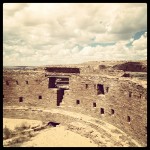I’ve driven from California to Colorado and back almost every Christmas for the last fifteen years. It’s a stunning drive, scenic and long. And I’ve always known that there were lots of mysteries waiting to be explored – I’ve just been too intimidated by it.
 I learned about Crow Canyon, a working archaeological research center headquartered in Cortez, Colorado after they held a fundraiser in Telluride, Colorado. Crow Canyon operates as a non-profit, and archaeology is expensive: tree ring dating, DNA samples, Data entry and analysis–it all costs money. Which is why Crow Canyon offers what they call Learning Tours, throughout the southwest and internationally as well.
I learned about Crow Canyon, a working archaeological research center headquartered in Cortez, Colorado after they held a fundraiser in Telluride, Colorado. Crow Canyon operates as a non-profit, and archaeology is expensive: tree ring dating, DNA samples, Data entry and analysis–it all costs money. Which is why Crow Canyon offers what they call Learning Tours, throughout the southwest and internationally as well.
They seemed like the perfect solution. I could see the Four Corners area, guided by working archaeologists who have worked in the region for years.
Altogether we formed a group of twelve – seven like me, three archeologists and two drivers-slash-make sure things don’t screw up people. The car was vibrating as if it might suddenly blow apart. Dust caked the windows, and the two cars had to be careful not to run into each other in the blinding red sand fog. We were on our way to Chaco Canyon and Pueblo Bonito – one of the largest examples of Anasazi ‘Great House’ architecture.
We got out and explored the ruins. The last of the Anasazi left the area midway through the 13th century, but it still dazzles. 635 rooms (depending on which archeologist you ask), five stories tall, taking up more than eight acres, Pueblo Bonito was build to impress. The masonry is intricate and impressive. Eight hundred year old wooden beams, hand carried over two hundred miles, helped support the massive structure.
Our guides, Mark Varien and Ricky Lightfoot, walked us through narrow doors, telling us what was found when the site was excavated, what the findings mean, what the rooms were used for, and how the Pueblos spent their days. (Lots of work!)
Some of the rooms looked like they had been recently renovated. But that was an illusion. The desert is a great preserver of antiquity, and the wooden beams I thought looked brand new were twelve hundred years old.
After a light lunch surrounded by – in my opinion – overly curious woodchucks, so curious they would wander within inches of our shoes – it was time to move on.
We got back in our trucks and headed back across the twenty miles of hardpan road. and back to the farm road that would take us to Aztec, New Mexico. Aztec Ruins, unlike Chaco Canyon, is smack dab in the middle of a town. One of the things it has going for it is it’s re-creation of a Great Kiva.
A kiva is a circular pit, usually dug into the ground, the top of which was covered in thatch or straw, with regular vents to allow smoke to escape. They sort of resemble ancient, empty hot tubs. Usually a family or a groups of families would have a kiva.
The Great Kivas were built on a community scale and were big enough for dozens of people to sit around in. This is where it was speculated that community leaders would address Puebloans, and where celebrations and religious rites would take place. The acoustics were great!
According to people who study such things, the capacity to take in any more than 800 words on the Internet doesn’t exist. So I’ll end here. But there’s more to come…
In the meantime, if you want to know more, visit here.






